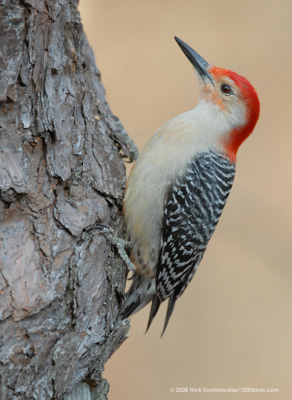Red-bellied Woodpecker
Category: Woodpeckers

Facts about Red-bellied Woodpeckers, "Scientific name for Red-bellied Woodpecker is Melanerpes carolinus". Red-bellied Woodpecker is a Melanerpes type of woodpecker. Red-bellied Woodpeckers are birds in the Class of "Aves". "Scientific name for Woodpecker Picidae".
The Red-bellied Woodpeckers hail from the northeastern parts of the United States and from the southern parts of Canada. The Red-bellied Woodpecker are largely found in the forests of the eastern parts of the country. The Red-bellied Woodpecker noticeably barred backs and shiny red caps make them a memorable sight, a somewhat more uncommon variety that is typically black on the back with large white-colored wing patches. Usually, the Red-bellied Woodpeckers make a contact call between mates, or a husky growl swapped when the Red-bellied Woodpecker are close together.
Features
The Red-bellied Woodpecker is a pale, average-sized bird, with a body length of 9.4 inches (23.87 cm), with the wingspan that ranges from 13 inches to 16.5 inches (33 to 41.9 cm). They have a body mass that ranges from 2 pounds to 3.2 pounds (.9 to 1.45 kg).
The Red-bellied Woodpecker has a sleek body, with a circular head. They are similar to some woodpecker varieties in size, but devoid of the blocky outlines. The Red-bellied Woodpecker appear with a pale-colored body, with the boldly black-and-white lined back, with blinking red color cap and nape. The Red-bellied Woodpecker shows its white patches close to the wingtips while the bird flies.
Usually, Red-bellied Woodpeckers used to hitch along trunks and branches of medium to large-sized trees, choosing at the surface of the bark of the tree more frequently than boring into it. Similar to the majority of woodpeckers, the Red-bellied Woodpecker has a distinctive undulating flight outline.
Red-bellied Woodpeckers have zygodactyl feet, having 4 fingers, which means they have two toes facing the front and two toes facing the back, that helps them to have a strong grip on trees vertically. The Red-bellied Woodpecker use these 8 fingers with their stiff central portion tail feathers to brace on trees as they climb.
The Red-bellied Woodpecker is widespread in several Eastern forests and woodlands, from aged stands of hickory and oak to juvenile pines and hardwoods. The Red-bellied Woodpecker will as well, frequently venture from woodlands to appear at garden feeders.
The Red-bellied Woodpecker used to wedge big nuts into the gaps of the bark, and then hit them into convenient pieces by using their beaks. The Red-bellied Woodpecker also employ cracks in fence posts and trees to accumulate food for the later part of the year, a custom it shares with supplementary woodpeckers in its type.
Red-bellied Woodpeckers tongue is up to 4 inches (10.16 cm) long. The length can be a little different depending on which species of woodpecker. The Red-bellied Woodpecker tongue wraps around the reinforced skull structured and squashy bone, to even out the impact of the pecking force. Many Red-bellied Woodpeckers have barbed tongues that helps them remove bugs from holes and tree bark.
Feathers that look like hairs on the Red-bellied Woodpecker nostrils, prevent ingestion of wood particles.
Diet
Though the Red-bellied Woodpeckers mainly feed on spiders, insects, and other arthropods, they also feed on copiousness of plant material. The Red-bellied Woodpecker feed especially on nuts, acorns, and pine cones, including seeds extracted from yearly and recurrent plants and fruits, ranging from blackberries and grapes to mangoes and oranges. Occasionally, the feed on nestling birds, lizards and even minnows.
There are more than 190 species of woodpeckers worldwide, but none of them are found in polar regions, Madagascar, New Zealand or Australia.
Male and female Red-bellied Woodpeckers are able to drum hollow trees logs execrate. Since Red-bellied Woodpeckers do not have vocal cords and don't sing, this pecking activity also plays an important role in communicating with each other. Red-bellied Woodpeckers drumming is also to attract a mate, mark out territory, both sexes are known to drum.
When feeding, drumming and building a nest cavity, a Red-bellied Woodpecker can peck up to 20 times per second, wow that's fast! or a total between 9,000 and 12,000 pecks in a day.
Red-bellied Woodpeckers have a prominent surge in flight comprise of three rapid wing flaps, followed by a quick glide when the Red-bellied Woodpeckers wings are tucked against its body rather than spread out like many other birds.
The average life span of a Red-bellied Woodpecker in the wild is 8 to 11 years, depending on the species and environment
Red-bellied Woodpeckers are omnivores; meaning - an animal that eats food of both animal and plant and origin.
Red-bellied Woodpeckers are monogamous meaning- the pair will mate for lifetime. Both male and female prepare the nest in the tree for babies and both will help feed them. The female Red-bellied Woodpecker will lay between 3 and 5 eggs and the incubation period will lasts 11 to 14 days. After one month of hatching, young Red-bellied Woodpeckers will leave the nest and venture out on there own.
Red-bellied Woodpeckers possess a protective ocular mechanisms for protecting its eyes from shaking from the pecking impact. woodpeckers show a restricted axial globe movement due to the tight fit within the fascial tissue connections and orbit between the sclera and orbital rim.
The eyes of the Red-bellied Woodpecker are covered with a nictitating membrane (from Latin nictare, to blink)— a translucent and transparent third eyelid - that protects the Red-bellied Woodpeckers eyes from flying debris while pecking.

 Back To Category Woodpeckers
Back To Category Woodpeckers